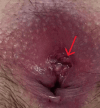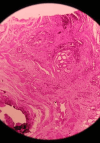Anal Canal Duplication With Abscess Formation and Associated Sacrococcygeal Hamartoma in an Adolescent: A Report of a Rare Case
- PMID: 40625501
- PMCID: PMC12229830
- DOI: 10.7759/cureus.85453
Anal Canal Duplication With Abscess Formation and Associated Sacrococcygeal Hamartoma in an Adolescent: A Report of a Rare Case
Abstract
Anal canal duplication (ACD) is a rare congenital malformation, typically diagnosed in pediatric populations, and often associated with other anomalies. Due to its nonspecific symptoms, it may be misdiagnosed or diagnosed late, particularly in adolescents or adults. We report the case of a 17-year-old female patient who presented with rectal pain, fever, and purulent perianal discharge. Physical examination revealed an accessory anal opening posterior to the native anus. Magnetic resonance imaging (MRI) demonstrated a perirectal abscess, a duplicated anal canal, and a suspicious presacral mass. A colonoscopy revealed a bulging rectum with normal mucosa. Surgical excision was performed for both the accessory anal canal and the presacral mass, and histopathological analysis confirmed the diagnosis of ACD and identified the mass as a benign sacrococcygeal hamartoma. This case highlights the diagnostic challenge of ACD due to its clinical resemblance to other perianal pathologies. Imaging modalities, particularly MRI and endoscopy, are critical for excluding differential diagnoses, guiding surgical management, and confirming post-surgical histopathology. ACD itself is a rare condition, with abscess formation being a rarely reported complication. The co-occurrence of ACD and a sacrococcygeal hamartoma is exceptionally rare and, to our knowledge, has not been previously reported. This case underscores the importance of a multidisciplinary approach for accurately diagnosing and effectively treating rare anorectal anomalies such as ACD, particularly when complicated by infection or associated with other anomalies.
Keywords: acessory anal canal; anal abscess; anal canal duplication; hamartoma; sacrococcygeal hamartoma.
Copyright © 2025, Al Ayoubi et al.
Conflict of interest statement
Human subjects: Consent for treatment and open access publication was obtained or waived by all participants in this study. Conflicts of interest: In compliance with the ICMJE uniform disclosure form, all authors declare the following: Payment/services info: All authors have declared that no financial support was received from any organization for the submitted work. Financial relationships: All authors have declared that they have no financial relationships at present or within the previous three years with any organizations that might have an interest in the submitted work. Other relationships: All authors have declared that there are no other relationships or activities that could appear to have influenced the submitted work.
Figures




Similar articles
-
Internal dressings for healing perianal abscess cavities.Cochrane Database Syst Rev. 2016 Aug 26;2016(8):CD011193. doi: 10.1002/14651858.CD011193.pub2. Cochrane Database Syst Rev. 2016. PMID: 27562822 Free PMC article.
-
The Black Book of Psychotropic Dosing and Monitoring.Psychopharmacol Bull. 2024 Jul 8;54(3):8-59. Psychopharmacol Bull. 2024. PMID: 38993656 Free PMC article. Review.
-
Signs and symptoms to determine if a patient presenting in primary care or hospital outpatient settings has COVID-19.Cochrane Database Syst Rev. 2022 May 20;5(5):CD013665. doi: 10.1002/14651858.CD013665.pub3. Cochrane Database Syst Rev. 2022. PMID: 35593186 Free PMC article.
-
Behavioral interventions to reduce risk for sexual transmission of HIV among men who have sex with men.Cochrane Database Syst Rev. 2008 Jul 16;(3):CD001230. doi: 10.1002/14651858.CD001230.pub2. Cochrane Database Syst Rev. 2008. PMID: 18646068
-
Lumbar sympathectomy versus prostanoids for critical limb ischaemia due to non-reconstructable peripheral arterial disease.Cochrane Database Syst Rev. 2018 Apr 16;4(4):CD009366. doi: 10.1002/14651858.CD009366.pub2. Cochrane Database Syst Rev. 2018. PMID: 29658630 Free PMC article.
References
-
- Anal duplication: is surgery indicated? A report of three cases and review of the literature. Trecartin AC, Peña A, Lovell M, Bruny J, Mueller C, Urquidi M, Bischoff A. Pediatr Surg Int. 2019;35:971–978. - PubMed
-
- Anal-canal duplication in a 6-year-old child. Ochiai K, Umeda T, Murahashi O, Sugitoh T. Pediatr Surg Int. 2002;18:195–197. - PubMed
-
- Colloid carcinoma arising within fistulae in the anorectal region. Dukes CE, Galvin C. https://pmc.ncbi.nlm.nih.gov/articles/PMC2377997/ Ann R Coll Surg Engl. 1956;18:246–261. - PMC - PubMed
-
- Anal canal duplication in infants. Choi SO, Park WH. J Pediatr Surg. 2003;38:758–762. - PubMed
-
- Anal canal duplication in adults: report of five cases. Gülen M, Leventoğlu S, Ege B, Menteş BB. Int Surg. 2016;101:20–23.
Publication types
LinkOut - more resources
Full Text Sources
